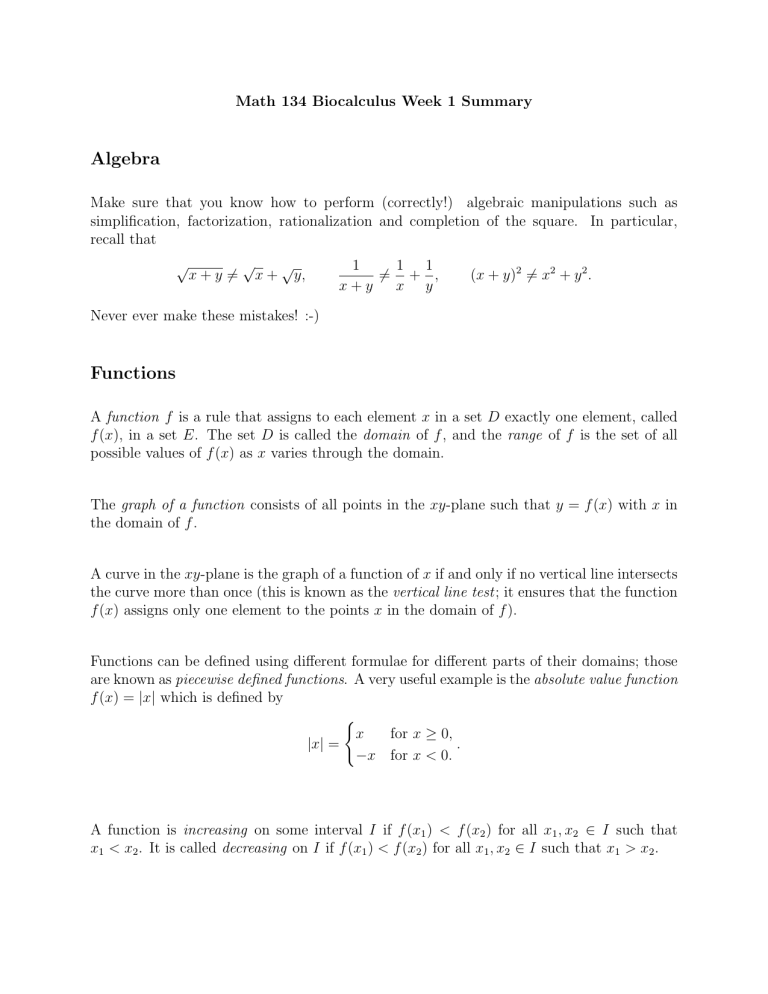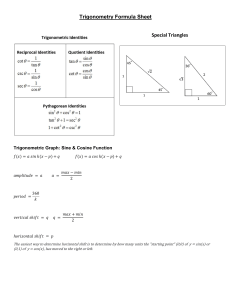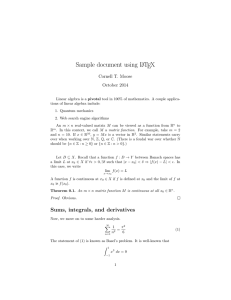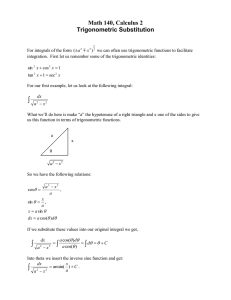
Math 134 Biocalculus Week 1 Summary Algebra Make sure that you know how to perform (correctly!) algebraic manipulations such as simplification, factorization, rationalization and completion of the square. In particular, recall that √ x + y 6= √ √ x + y, 1 1 1 6= + , x+y x y (x + y)2 6= x2 + y 2 . Never ever make these mistakes! :-) Functions A function f is a rule that assigns to each element x in a set D exactly one element, called f (x), in a set E. The set D is called the domain of f , and the range of f is the set of all possible values of f (x) as x varies through the domain. The graph of a function consists of all points in the xy-plane such that y = f (x) with x in the domain of f . A curve in the xy-plane is the graph of a function of x if and only if no vertical line intersects the curve more than once (this is known as the vertical line test; it ensures that the function f (x) assigns only one element to the points x in the domain of f ). Functions can be defined using different formulae for different parts of their domains; those are known as piecewise defined functions. A very useful example is the absolute value function f (x) = |x| which is defined by ( x for x ≥ 0, |x| = . −x for x < 0. A function is increasing on some interval I if f (x1 ) < f (x2 ) for all x1 , x2 ∈ I such that x1 < x2 . It is called decreasing on I if f (x1 ) < f (x2 ) for all x1 , x2 ∈ I such that x1 > x2 . A linear function f (x) is a function of the form f (x) = mx + b, for some constants m and b. Its graph is a line with slope m and y-intercept b. A polynomial function f (x) is a function of the form f (x) = an xn + an−1 xn−1 + . . . + a1 x + a0 , for some constants an , an−1 , . . . , a1 , a0 and some positive integer n. The degree of f (x) is n. When n = 2, f (x) is called quadratic, while it is called cubic if n = 3. A power function is a function of the form f (x) = xa for some constant a. If a is a positive integer, then f (x) is a particular example of a polynomial function. If a = 1/n with n a positive integer, then f (x) is a root √ function (for example, for a = 1/2 it is the familiar square root function f (x) = x1/2 = x). For a = −1, it is the reciprocal function f (x) = 1/x. A rational function is a function of the form f (x) = P (x) Q(x) where P (x) and Q(x) are polynomial functions. An algebraic function is a function that can be constructed using algebraic operations (such as addition, subtraction, multiplication, division, and taking roots) starting with a polynomial function. All rational functions are clearly algebraic. Completing the Square A function f (x) = ax2 + bx + c can be rewritten as f (x) = a(x + p)2 + q 2 b b and q = c − 4a . The function f (x) is a parabola with its vertex at (−p, q). It where p = 2a opens upward of a > 0 and opens downward if a < 0. Transformations of Functions • y = f (x) + k shifts the graph of f (x) up by k units if k > 0 and down by |k| units if k < 0. • y = f (x − k) shifts the graph of f (x) by k units to the right if k > 0 and down by |k| units to the left if k < 0. • y = cf (x), c > 1 stretches the graph of f (x) vertically by a factor of c. • y = cf (x), 0 < c < 1 compresses the graph of f (x) vertically by a factor of 1/c. • y = f (cx), c > 1 compresses the graph of f (x) horizontally by a factor of c. • y = f (cx), 0 < c < 1 stretches the graph of f (x) horizontally by a factor of 1/c. Geometry Lines Given two points P1 (x1 , y1 ) and P2 (x2 , y2 ) in the xy-plane, ∆x = x2 − x1 ∆y = y2 − y1 is called the change in x, or the “run” is called the change in y, or the “rise”. If x1 6= x2 , the line passing through the points P1 and P2 is non-vertical, and its slope is m= rise ∆y y2 − y1 = = x2 − x1 ∆x run If P1 6= P2 but ∆y = 0 then m = 0 and the line is horizontal. If P1 6= P2 but ∆x = 0 then the line is vertical, and its slope is undefined. A vertical line is not the graph of a function, since it does not pass the vertical line test. Typically we give the equation of a line in the form y = mx + b, where m is the slope and b the y-intercept. Two lines y = m1 x + b1 and y = m2 x + b2 are parallel if m1 = m2 . They are perpendicular if m1 = −1/m2 . To find the equation of the line with a given slope m = a passing through a point P (x1 , y1 ), we can use the point-slope formula: y − y1 = m(x − x1 ). We expand and gather terms to get an equation of the form y = mx + b. To find the equation of the line passing through two points P1 (x1 , y1 ) and P2 (x2 , y2 ), we first determine that the slope of the line is y2 − y1 m= , x2 − x1 and then substitute into the point-slope formula to get y2 − y1 y − y1 = (x − x1 ). x2 − x1 We expand and gather terms to get an equation of the form y = mx + b. Circles, parabolas, ellipses and hyperbolas The equation of a circle with centre (h, k) and radius r is (x − h)2 + (y − k)2 = r2 . A parabola is the graph of a function of the form y = ax2 + bx = c. The equation of an ellipse with centre (h, k) has the form (x − h)2 (y − k)2 + = 1, a2 b2 for some constants a and b. The equation of a hyperbola with “centre” (h, k) has the form (x − h)2 (y − k)2 − = 1, a2 b2 for some constants a and b. Trigonometry Angles can be given either in degrees or radians. A complete revolution corresponds to 360o or 2π radians. The two basic trigonometric functions are sin θ and cos θ. If you pick a point (x, y) on the unit circle, with angle θ with respect to the positive side of the x-axis (positive angle meaning counterclockwise rotation), then the trigonometric functions are defined as x = cos θ, y = sin θ. These two trigonometric functions can also be obtained from the length of the sides of a right triangle, as: opposite adjacent sin θ = , cos θ = . hypotenuse hypotenuse The four other trigonometric functions can be obtained from sin θ and cos θ as: tan θ = sin θ , cos θ cot θ = cos θ , sin θ sec θ = 1 , cos θ csc θ = 1 . sin θ Trigonometric functions satisfy many identities, which you can easily find online or in Appendix D of the textbook. The most important one is sin2 θ + cos2 θ = 1, and the two other similar identities that can be obtained from this one through the relations above: tan2 θ + 1 = sec2 θ, 1 + cot2 θ = csc2 θ. Functional Composition Given two functions f and g, the composition of f with g is a function defined by f ◦ g(x) = f (g(x)). The domain of f ◦ g is the set of all x in the domain of g such that g(x) is in the domain of f .




